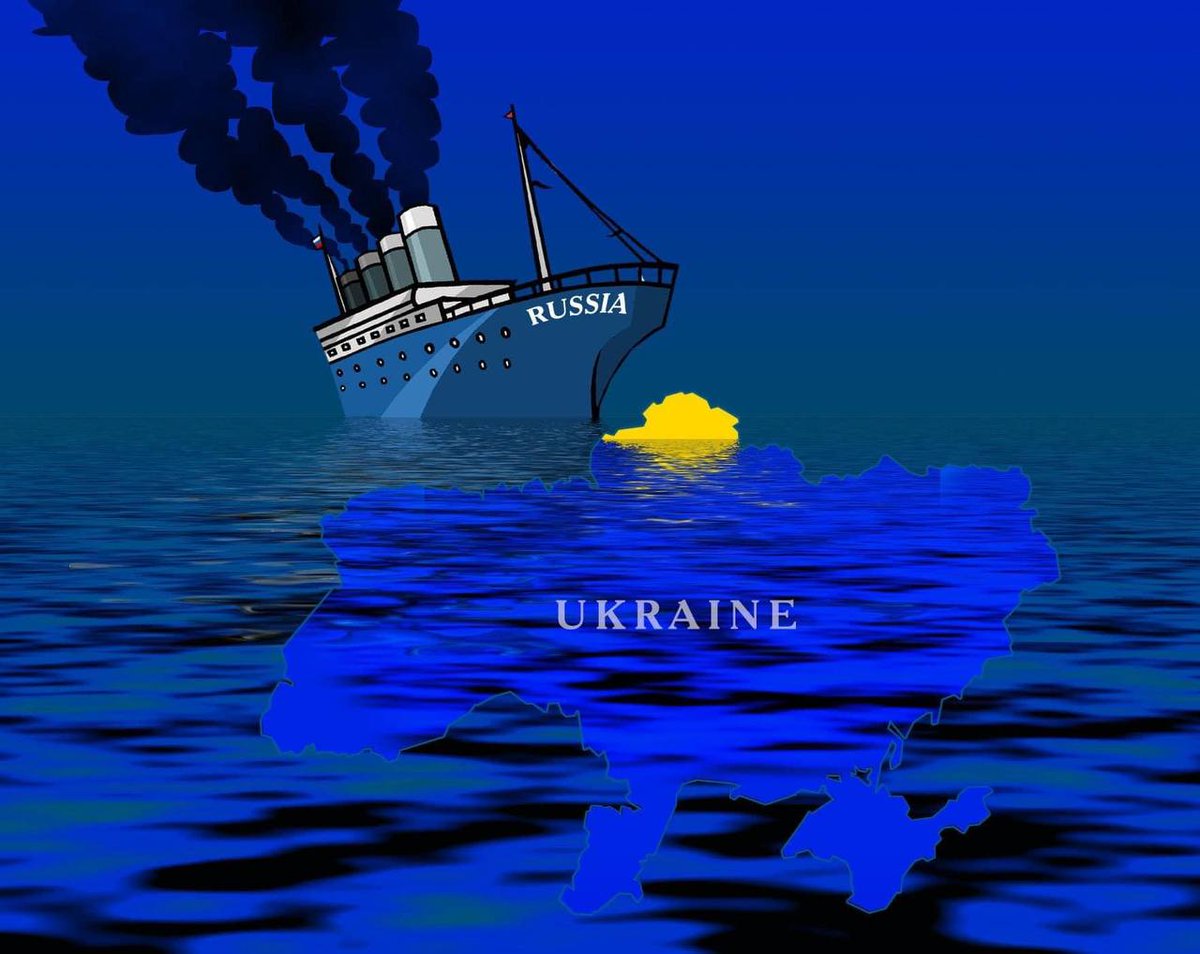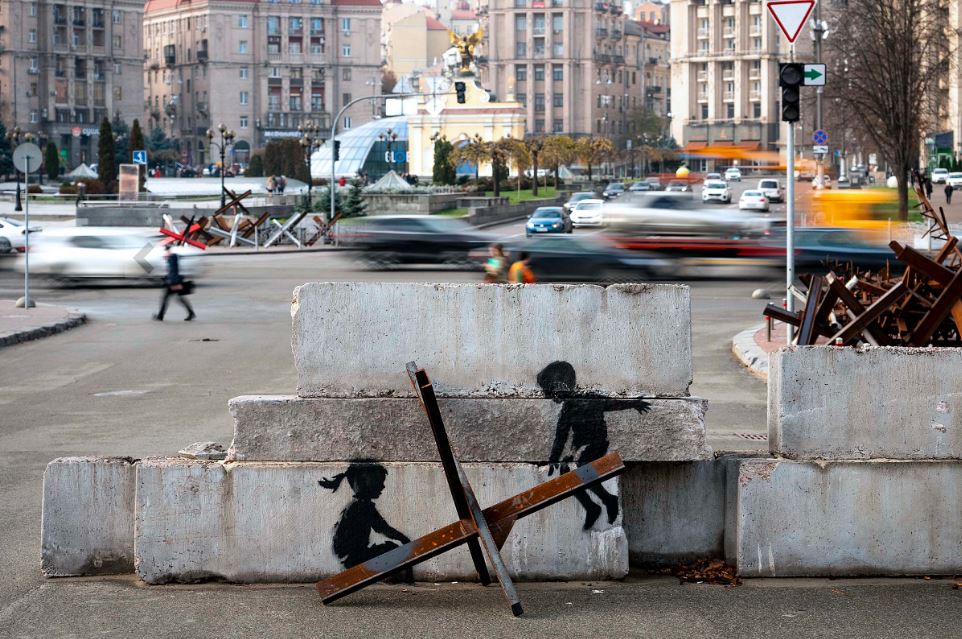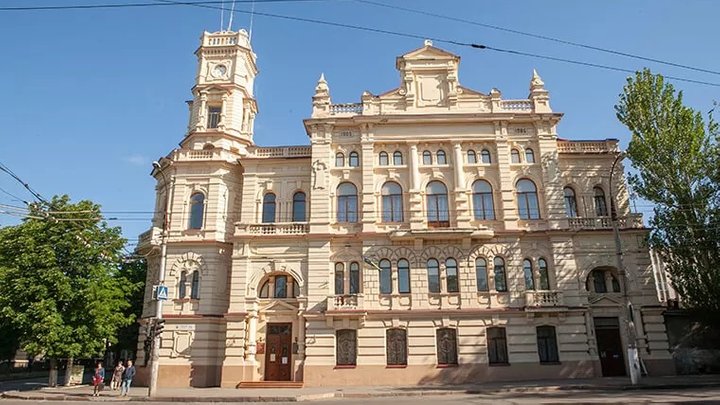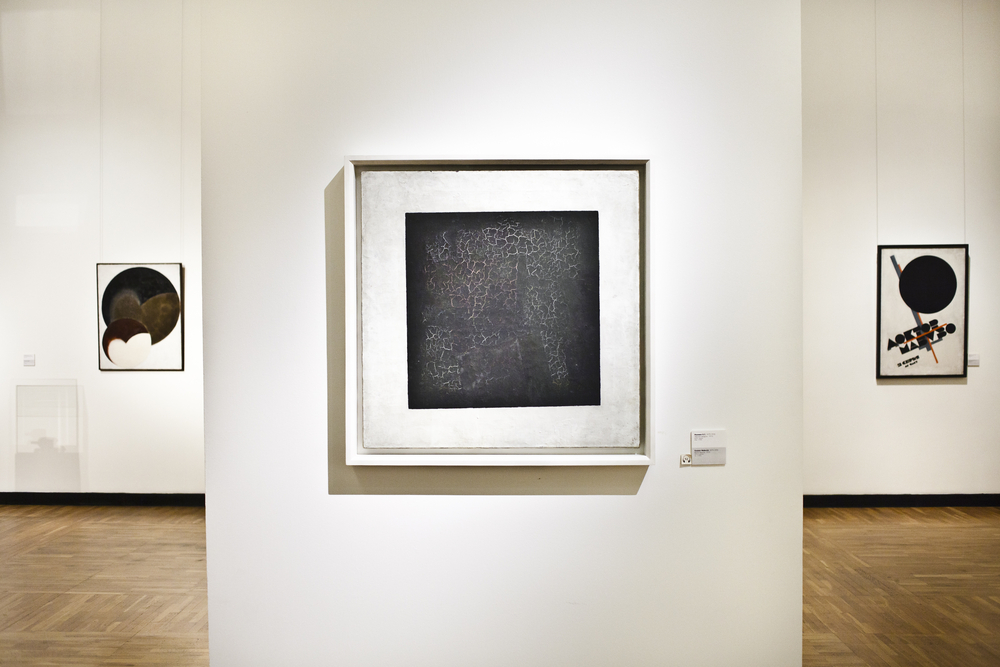Ukrainian illustrators draw the war
The Facebook group where Ukrainian illustrators publish their works about the war is called Illustraсtor. The punreferences the many occasions in which Ukrainian Ukrainian farmers used their tractors to take for themselves Russian tanks that had been abandoned by Russian troops. Tanks can be sold for scrap metal, or, if in good condition, converted to support the needs of Ukraine’s army. Ukrainian farmers – but also Illustrator artists – try to turn adversity into strength, finding a source of power amidst the darkness of war.

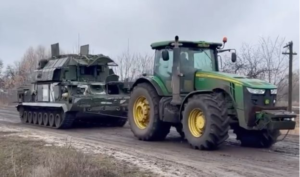
Dozens of new drawings appear in the group every day. Here is the selection of some of the most expressive works by Ukrainian illustrators about the war explained in context.
The horror of the war
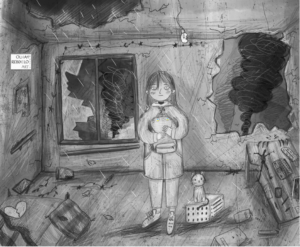
According to Ukraine’s Defense Minister, during the first two weeks of war more Ukrainian civilians than soldiers were killed by Russia. The destruction caused by Russian aggression, according to the preliminary estimations, is close to the annual State Budget of Ukraine.
In this drawing by Olha Rebdelo, a girl stands in her destroyed flat. Everything is grey and frightening: the only colourful, yet almost unnoticeable, details are the blue-yellow hearts on the exhausted girl’s backpack.
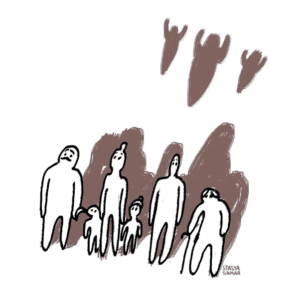
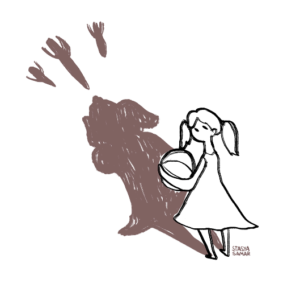
Anastasiya Samarkina dedicated these illustrations to the tragedy in Mariupol. Since 1 March, for 24 days at publication time, Mariupol residents have been encircled by Russian troops, living under constant shelling, which on some days has occurred every 30 minutes. As of 13 March, 2,187 Mariupol residents were killed by Russian missiles and bombs.
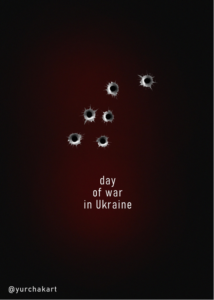
The call for unity
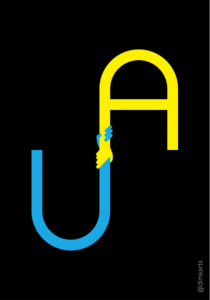
Since the outbreak of the war, Ukrainian civil society, culture, community, and business have united their efforts with the army to defend the country.
“The most important thing is that all people gather together and we have each other.”–said Kyivan volunteer Olha, who worked as an entrepreneur before the war.

The illustration refers to the Ukrainian level of bravery is such that a single civilian can stop a Russian tank alone; the Russian level of bravery is such that hundreds of protestors flee from a single police officer.
Another interpretation of this visual refers to the extensive use of “cannon fodder” tactics and authoritative command in the Russian army compared to the “quality over quantity” approach in the Ukrainian army in conjunction with the personal responsibility of Ukrainian soldiers, territorial defense, and civilians.
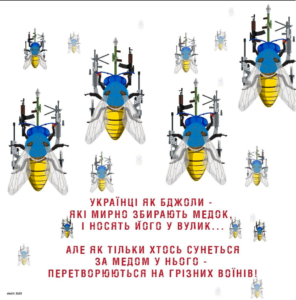
The text on the illustration by Bohdan Cholli states:
“Ukrainians are like bees who peacefully collect honey and carry it to the hive… But as soon as someone pushes for the honey inside – they turn into formidable warriors.”
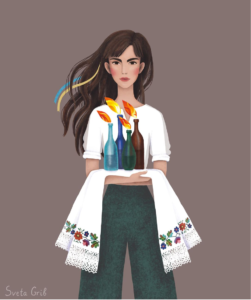
Ukrainians are famous for their hospitality. Here, however, illustrator Sveta Grib shows how “hospitable” Ukrainians are to “guests” who are not invited.
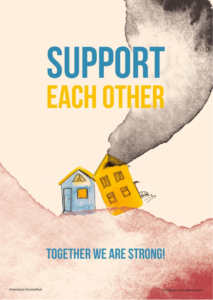
While about 2.5 million people fled Ukraine after Russia's invasion, a further two million have been internally displaced by the war, according to the UN refugee agency’s report on 11 March.
What about Russians?
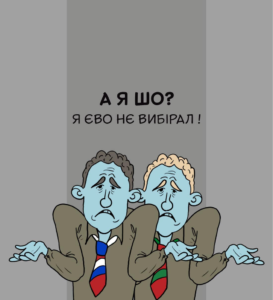
The text on the illustration by Roman Tkachuk states:
“What me? I didn’t elect him”
The illustration points out the reluctance of Russian and some Belarus citizens to accept responsibility for the Russian invasion. Simultaneously, an independent poll suggests that Russians largely support the invasion of Ukraine, and despite sanctions, they hope for the “Growth of Russia’s influence in the world.”
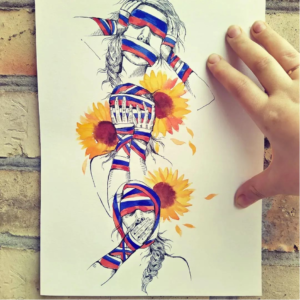
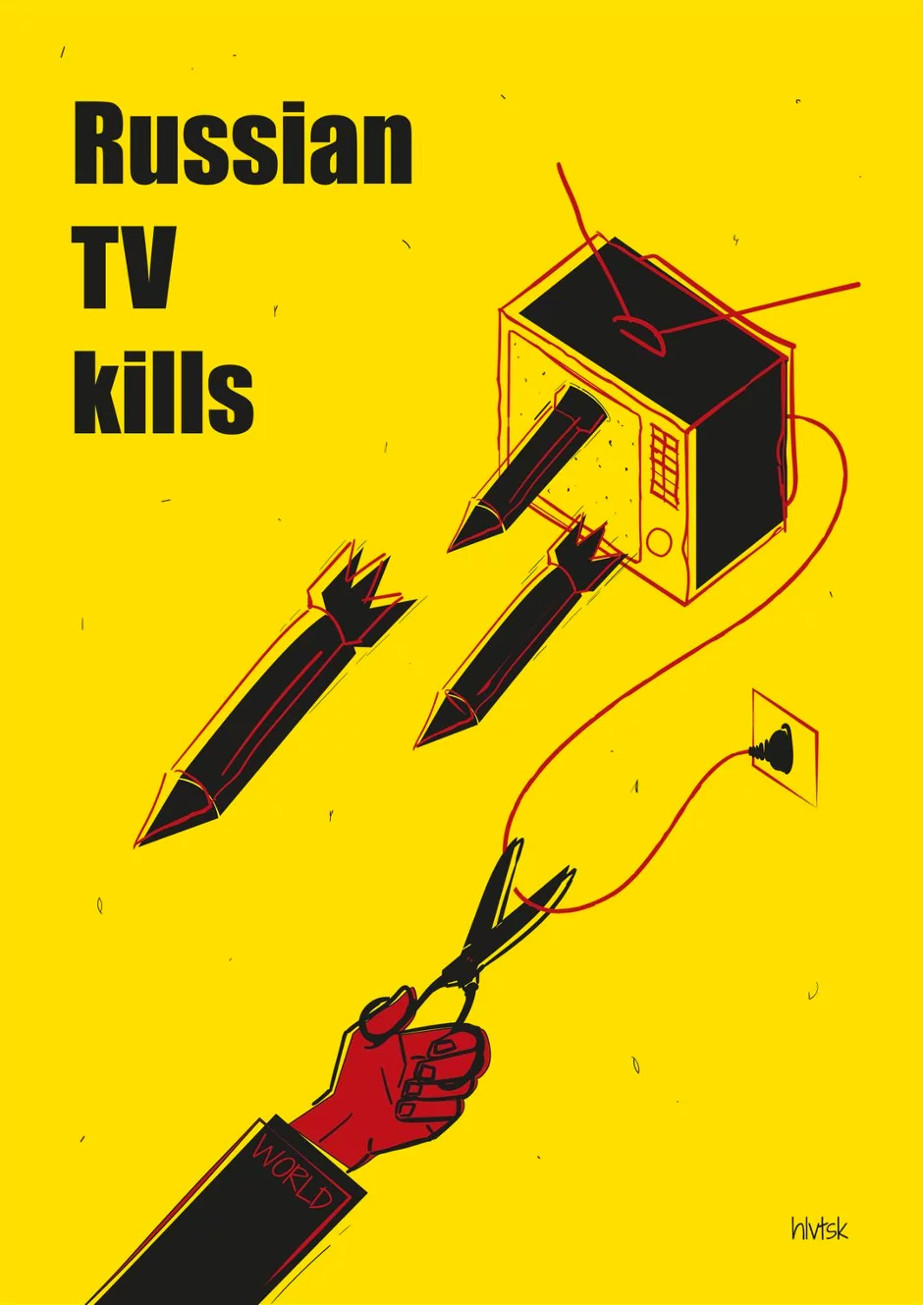
Television is effectively used by Russia to spread disinformation, small and big lies, including headlines about “Donbas genocide” and an “impending Ukrainian attack”. This is a tendency with significant precedent:
“We’re not on TV right now — we can tell the truth,” said
Russian TV host off-air in 2019
Even in 2017, Russian TV was dominated by topics about Ukraine, brewing hatred among the Russian population towards Ukraine. Since Russia’s full-scale invasion, international and Ukrainian hackers have launched cyberattacks to block access to Russian TV propaganda within Russia.
What about the Russian leader?
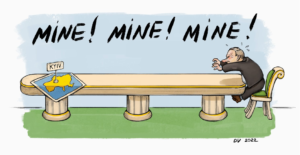
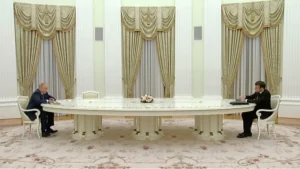
This illustration refers to the Putin-Macron meeting on 11 February and, generally, to the paranoid and undemocratic style of politics and international relations in Russia’s authoritative regime.
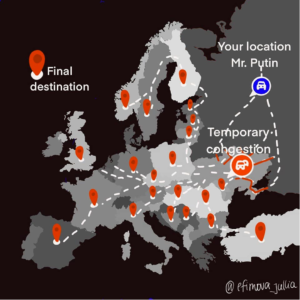
While many claim that Ukraine is just an intermediate goal in Russia’s imperialist ambitions, some suggest that World War III has already begun.

In negotiations with Russia, representatives of Ukraine and the Ukrainian delegation maintain to do everything to reach a diplomatic solution. However, following the Russian escalation and more criminal shelling of civilians in the last week, a number of commentators claim that Russia can be defeated only militarily.
What are Ukrainians asking for from the West?
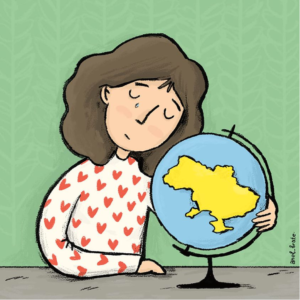
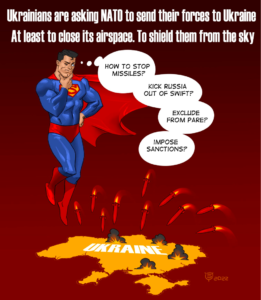
The no-fly zone remains the most significant appeal of Ukrainian people and officials to NATO. With the intensification of Russian airstrikes and disruptions of humanitarian corridors, the necessity for military defence has grown significantly. Moreover, Russians anticipated such intense sanctions yet still supported the invasion after it began. While US officials claim that a no-fly zone would mean that NATO had entered the war, experts observe that NATO is already part
of the conflict.
After new air defense systems were provided to Ukraine, Ukrainian military experts say Ukraine will soon be able to repel air attacks on its own.
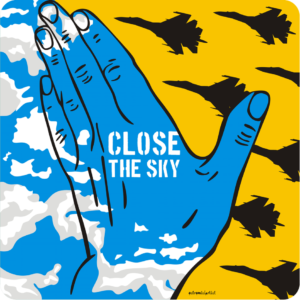
After all, it’s all about hope
Amidst the darkness of war, Ukrainian illustrators fiercely hope for freedom and the life they had before Russia started the war.
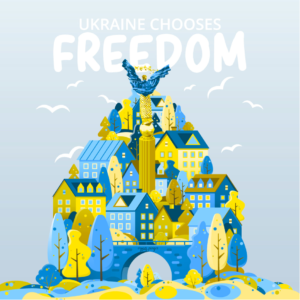
91% of Ukrainians feel hope when thinking about the situation in Ukraine. This is true among all Oblasts of the country, according to a recent poll.
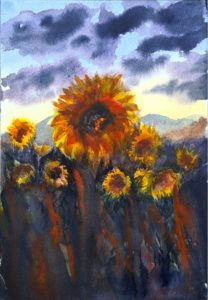
Sunflowers are an important symbol of Ukraine. In the 2021/2022 crop year, Ukraine had the highest production volume of sunflower seeds of any country in the world.
Illustrator Natalia Li commented on her and other illustrators’ drawing In the Illustractor Facebook group:
“I see many sunflowers drawn. Those sunflowers are beautiful. Mine are very painful, but as it is.
…And the sunflowers will bloom.
Quiet night to you”
Related:
- Russia disrupts humanitarian convoys and evacuation from the war zone in Ukraine Since the start of Russia’s full-scale invasion of Ukraine on 24 February, many Ukrainian civilians who found themselves in the warzone or near the frontlines started fleeing the hostilities to safer regions of Ukraine and to the EU countries. However, Russia systematically blocks, hinders, or disrupts multiple humanitarian efforts attempted by Ukraine: obstructs the exit of the convoys out of the occupied settlements, and fires along the routes or even at the convoys themselves.
- Making Russia answer for destroying cultural heritage in Ukraine Russia’s war against Ukraine takes not only human lives: it has already decimated centuries-worth of cultural heritage. When does such destruction constitute a war crime and what can be done to make Russia answer for the irreparable damage?

